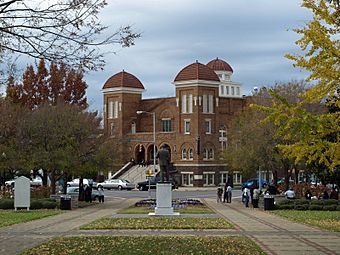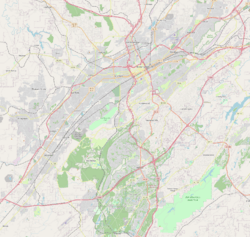Birmingham Civil Rights District facts for kids
Quick facts for kids |
|
|
Birmingham Civil Rights Historic District
|
|

16th Street Baptist Church, as seen from Kelly Ingram Park. A statue of Martin Luther King Jr. faces the church.
|
|
| Location | Roughly bounded 9th Ave., Richard Arrington Jr. Blvd., 1st Ave. and 14th St., Birmingham, Alabama |
|---|---|
| Area | 36 acres (15 ha) |
| Built | 1963 |
| Architect | Turner, Smith & Baston; et al. |
| Architectural style | Classical Revival, Gothic Revival |
| MPS | Civil Rights Movement in Birmingham, Alabama MPS |
| NRHP reference No. | 06000940 |
| Added to NRHP | October 19, 2006 |
The Birmingham Civil Rights District is a special part of downtown Birmingham, Alabama. It's where many important events happened during the Civil Rights Movement in the 1950s and 1960s. This movement was a fight for equal rights for all people, especially African Americans. The district was officially recognized by the City of Birmingham in 1992. It covers about six city blocks.
Contents
Exploring the Birmingham Civil Rights District
This historic area helps us remember the brave people who worked for fairness and equality. It shows how much change happened in the United States.
Important Places to Know
The district includes several key landmarks that played a big role in the Civil Rights Movement.
16th Street Baptist Church
The 16th Street Baptist Church was a very important meeting place. In 1963, young people involved in the Birmingham campaign and the Children's Crusade were trained here. They learned how to peacefully protest for their rights. Groups of 50 would leave the church to march towards City Hall.
Sadly, on September 15, 1963, the church was bombed. Four young girls were killed, and 22 other people were hurt. This terrible event shocked the nation and highlighted the violence faced by civil rights activists.
Kelly Ingram Park
Kelly Ingram Park was a central spot for many protests by African Americans. Often, these peaceful protests were met with harsh actions from the Birmingham police. In 1963, there were famous scenes of police using powerful fire hoses and police dogs against young protesters.
News reports and images of these events were shown across the United States. This helped many people understand the unfairness and cruelty of segregation. It made more Americans support the end of laws that separated people based on race. Today, the park has sculptures that show scenes from these protests.
Fourth Avenue Business District
The Fourth Avenue Business District was a busy area for black-owned businesses and entertainment. For many years, it was the heart of the black community in Birmingham.
This district included places like the Booker T. Washington Insurance Co., owned by A. G. Gaston. It also had the Gaston Motel. The Gaston Motel was a key meeting spot for civil rights groups like the Southern Christian Leadership Conference and the Alabama Christian Movement for Human Rights in the early 1960s.
Carver Theatre
The Carver Theatre was once a popular movie theater for black residents in Birmingham. It has been updated and is now a place for live performances. It is also home to the Alabama Jazz Hall of Fame.
Birmingham Civil Rights Institute
The Birmingham Civil Rights Institute is a museum that opened in 1993. It tells the story of the Civil Rights Movement. The museum shows the events, actions, and successes of the movement. It helps visitors understand the struggles and triumphs of those who fought for equality.
Becoming a National Historical Park
On March 21, 2016, Representative Terri Sewell suggested a bill to the United States House of Representatives. This bill aimed to make the Birmingham Civil Rights District a National Historical Park.
While the full park designation was still being discussed, a part of the district was given a special status. On January 12, 2017, President Obama used an executive order to name a portion of the district the Birmingham Civil Rights National Monument. This means it is now a protected area managed by the National Park Service.
See also




